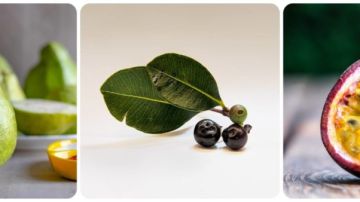9 Fun Facts about Fruits Indigenous to Latin America
Fruits like açaí and pitaya are indigenous to Latin America and though they've been trending recently in the U

Photo: Unsplash/VD Photography, Don Kaveen, Michael Kucharski
Fruits like açaí and pitaya are indigenous to Latin America and though they’ve been trending recently in the U.S. they’ve been a part of our diets for centuries. Fruits like açaí berries have been eaten by Indigenous people in Brazil and the Shaur tribe of Peru use açaí for medicinal purposes to this day. We wanted to take a moment to recognize the origins of some of the fruits you’re probably consuming regularly without knowing its history. Read on to learn more about the origin and uses of some of Latin America’s most beloved and popular fruits.
wp_*posts
Pitaya

Pitaya, or Dragon Fruit, is native to Mexico and Central America and grows on a cactus plant. People usually eat both the flesh and the seeds especially during the warmer months. It’s rich in antioxidants, magnesium, and fiber and is similar in texture to kiwi.
wp_*posts
Açaí

Açaí is a deep purple fruit native to the tropic regions of Central and Southern America. This fruit has been known to be an important food source for the Indigenous people of the Amazon and has been gaining popularity within the United States. It’s high in antioxidants, omega fatty acids, and essential amino acids.
wp_*posts
Guavas

Guavas (Guayaba) are native to Mexico, Central and South America though it now thrives in warm tropical climates throughout LATAM. The Mayans used not only the fruit itself but also used the leaves and roots as medicine. Packed with vitamin C, these deliciously sweet fruits can boost immunity, lower blood sugar levels, and benefit your digestive system.
wp_*posts
Cherimoyas

Cherimoya was originally grown in the valleys of the Andes Mountains in Ecuador and Peru. In Peru, this fruit is often referred to as the “lost fruit of the Incas.” It has a soft texture that almost melts in your mouth and has a fragrant flavor, very similar to a sugar apple. While it’s skin and seeds are toxic, the meat itself is said to have many benefits including lowering blood pressure, reducing inflammation, and boosting immunity. Another fun fact: cherimoya is (unofficially) considered the national fruit of Chile to some of its citizens. Scoop out the custardy inside and pour some orange juice over it for a traditional Chilean dessert, “Chirimoya Alegre.”
wp_*posts
Jackfruit

Jackfruit is grown throughout many subtropical parts of LATAM like Brazil, Puerto Rico, and the Caribbean. It is considered the world’s largest tree fruit with each individual fruit weighing up to about 80 pounds! You can actually cook and it’s often used as a meat substitute in vegan meals for its texture. This fruit is very easy to digest and high in vitamins A and C and iron.
wp_*posts
Passion fruit

Passion fruit is Indigenous to Brazil, Paraguay, and Northern Argentina. Its flower (Passiflora edulis) was known by as the Flor de las cinco lagas (flower of the five wounds) by Spanish missionaries because it illustrated the crucifixion of Christ.You usually eat the yellow pulp but avoid eating the seeds as they can taste very bitter. Passion fruit is high in antioxidants, a great source of fiber, and reduces anxiety.
wp_*posts
Cashew Fruit

The cashew tree is native to Brazil which produces both the cashew nut and the cashew apple. This fruit is a good source of vitamin C and magnesium making it great for tissue and bone growth. For a sweet snack, make some doce de caju (stewed cashew apples). All you need are some ripe cashew fruits, lime, water, and sugar.
wp_*posts
Prickly Pear Cactus

Prickly pears are native to the Americas, and mostly found in Mexico. The ancient Aztecs considered this fruit to be sacred and it’s also featured on Mexico’s flag.The prickly pear cactus fruits (tunas) can be eaten as is or you can make it into a delicious agua fresca.
wp_*posts
Tomate de Árbol

No one can exactly pinpoint where tomate de arbol originate from but it’s found in the Andes of Peru, Chile, Ecuador, and Bolivia. Although it’s not native to Colombia, it’s extensively grown there and is quite popular. It has a tangy taste with a bit of sweetness and is an excellent source of vitamins A, B6, C, and E. It’s commonly consumed as a juice and its leaves are heated and placed on inflamed tonsils.

















